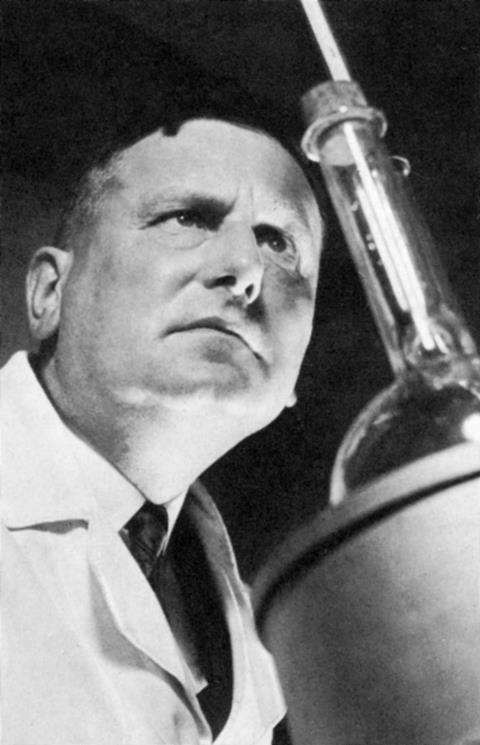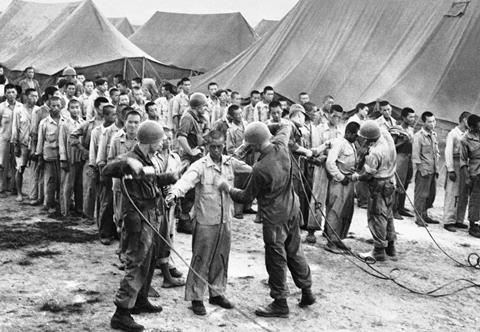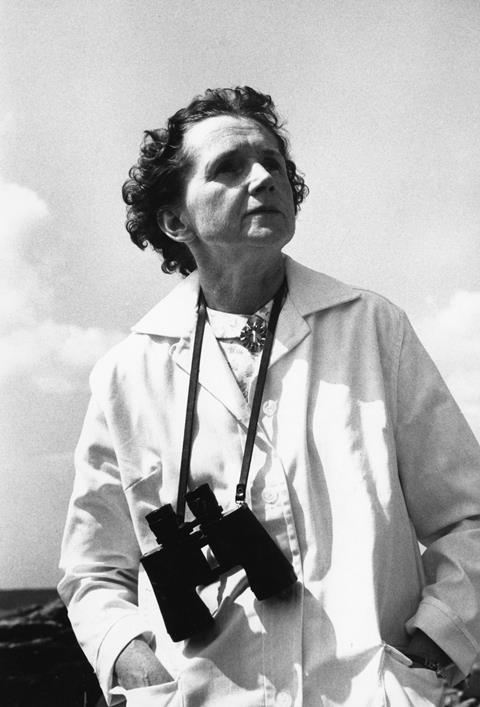Few compounds have a story as controversial as this insecticide. Mike Sutton traces the tale from its beginning 150 years ago
Before its synthesis in 1874, dichloro-diphenyl-trichloroethylene was unknown to science. For decades afterwards, it remained one among many (apparently) useless chemical compounds prepared by PhD students and subsequently ignored. Then in the 1940s, it was found to have a lethal impact on insects that transmit serious human diseases.
Under the stress of war DDT’s production was prioritised, and it saved many lives in barracks and refugee camps. When peace returned, it powered ambitious public health projects and was welcomed by insect-plagued farmers and homeowners. But gradually it became apparent that DDT does not degrade quickly into less toxic substances. It can accumulate in the biosphere, moving up food chains until it reaches lethal levels in some species.
At first, government officials and chemical industry executives argued that DDT was not a significant hazard for humans, but public concern increased following the 1962 publication of Rachel Carson’s Silent Spring. Legislation restricting the use of DDT (and newer organo-chlorine insecticides like lindane, aldrin, and dieldrin) eventually followed.
Today, well-funded advocates are campaigning to restore DDT’s reputation. They argue that using it against mosquitos could prevent millions of human deaths from malaria – with relatively limited environmental impact. While this compound’s future remains in debate, another look at its history might be useful.
Routine thesis fodder
In 1874, DDT’s synthesis did not seem a momentous event. Its German godfather, the future Nobel laureate Adolf Baeyer, was then only three years into his first full professorship, having previously spent over a decade in post-graduate research and lower-level teaching jobs. And when Baeyer’s Austrian PhD student Othmar Zeidler condensed chlorobenzene with chloral hydrate, the result was simply routine thesis-fodder.
After graduating, Zeidler returned to Vienna and became a pharmacist. His discovery – though published in the Berichte der Deutsche Chemischen Gesellschaft in 1874 – attracted minimal attention until the Swiss chemist Paul Müller encountered it in 1939.
Müller, born in 1899, completed his doctorate at Basel University in 1925 and was immediately hired by prominent local firm Geigy, one of Switzerland’s largest chemical manufacturers. Initially, Müller worked on plant pigments and leather-tanning agents, but from 1935 he focused on insecticides. He later recalled his sense of ‘moving into unknown territory where there are no points of reference to begin with so that we can only proceed by feeling our way … Already an immense amount of literature existed on the subject and a flood of patents had been taken out. Yet of the many patented pesticides there were practically none on the market.’
Insecticidal power
In 1939, Müller noticed a 1934 publication by two British chemists at Oxford University, Frederick Chattaway and Roland Muir. They described the preparation of diphenyl-trichloro-ethane by condensing benzene with chloral hydrate, using concentrated sulfuric acid as a dehydrating agent. The authors referenced Zeidler’s 1874 synthesis of an analogous compound and noted that their new substance had insecticidal powers.

Müller had apparently been unaware of Zeidler’s paper until then. However, he already knew that Geigy’s powerful new moth-repellent product, Mitin, contained a chloro-phenyl derivative. Perhaps suspecting that Chattaway and Muir’s compound might be more effective if its phenyl groups were chlorinated, he repeated Zeidler’s synthesis, and quickly found that DDT ‘showed a strong insecticidal contact action such as I had to date never observed in any substance’, he wrote. ‘My fly cage was so toxic after a short period that even after very thorough cleaning of the cage, untreated flies, on touching the walls, fell to the floor. I could carry on my trials only after dismantling the cage, having it thoroughly cleaned and after that leaving it for about one month in the open air.’
Field trials demonstrated the compound’s potency against the Colorado beetles then ravaging Switzerland’s potato crop, and by 1942 Geigy was ready to mass-produce it. The standard synthesis yields a mixture of isomers, the para-para one being the commonest, and the most toxic to insects.
Wartime wonder
Observing Switzerland’s policy of strict neutrality, Geigy offered to sell – or license – DDT to all participants in the ongoing second world war. However, it was the US which deployed the agent most effectively. An early demonstration of its value came in 1944, when the US army dusted thousands of civilians with DDT powder to suppress a typhus epidemic in the Italian city of Naples.

Meanwhile DDT, dissolved in oil, was being sprayed on water-logged areas around Allied military camps. In hot climates, stagnant water provides a productive breeding-ground for mosquitoes – the carriers of the microscopic parasites which cause malaria – but this new chemical assault kept many more troops malaria-free and fit for action. Powdered DDT also proved effective against the disease-bearing lice which infested millions of ex-prisoners and refugees during the chaotic months following the war’s conclusion in 1945.
Peacetime demand for the new product was massive. Governments used it extensively in campaigns against malaria, which by 1951 had effectively disappeared from Italy and the US – though it remained endemic in African and Asian countries which lacked the infrastructure to sustain comprehensive eradication programmes. Meanwhile, DDT suppressed many troublesome agricultural pests, and gave home-owners relief from invasive insects. Hailed as a scientific miracle, it earned Müller the Nobel prize for medicine in 1948.
Environmental concerns
For two decades DDT was used extensively (and often excessively) on crops and in homes. It was also wasted in attempts to control polio epidemics – on whose viral carriers it had no effect. This ‘saturation bombing’ enhanced the pressure of natural selection on all of the mosquito family’s 3500-plus species, hundreds of which belong to the sub-family Anophelenae – malaria’s transmitters. Whenever random mutations produced a few insects that DDT couldn’t kill, the massacre of their rivals left these survivors room to multiply. By the mid-1950s, scientists were already beginning to notice some resistant mosquitoes.

Meanwhile, anxiety about DDT’s environmental impact increased, particularly among ornithologists and bee-keepers. A few landowners also complained that spraying by neighbouring farmers had harmed their livestock, and unusual illnesses began appearing in a small riverside community downstream from a DDT production plant in the US state of Alabama. But while toxicologists struggled to deliver precise estimates of the long-term hazards of the new insecticides, assessing risk levels remained difficult.
It was clear, however, that insects absorbed DDT through their skins. It then passed directly to their nervous systems, causing spasms followed rapidly by death. In contrast, animals (and humans) who ingested DDT generally excreted or absorbed it without any immediately observable effects. Nevertheless, it appeared that DDT could accumulate in fatty tissues, and there were fears that it might reach dangerous levels in breast milk.
Many more people became anxious after Rachel Carson’s 1962 Silent Spring highlighted the wide-ranging impact of pesticides. Bees – and other agriculturally essential pollinators – were dying in huge numbers alongside the targeted pests. Meanwhile, birds and small animals that feasted on the insects killed by DDT suffered serious (and often fatal) neurological damage. The term food chain gradually filtered into everyday language – but as yet there was no clear answer to the crucial question ‘could we be next?’
During the 1960s, demands to ban (or more strictly regulate) DDT and similar pesticides increased, and the issue rapidly became politicised. Elected representatives from agricultural regions, and from districts that hosted large chemical manufacturers, were understandably worried about preserving their voters’ livelihoods. Professional lobbyists – funded by large chemical companies and industrial-scale farmers – offered the politicians ready-packaged arguments against pesticide regulation, and soon they acquired an influential ally.
After the health hazards of cigarettes became a serious concern, analysis revealed that their smoke contained DDT – amongst other problematic compounds. Tobacco companies already employed public relations experts to persuade customers that smoking was (relatively) harmless. Now, DDT joined the list of substances about which smokers were worrying. But when the US National Agricultural Chemicals Association opposed legislation limiting the use of insecticides, cigarette manufacturers supported them vigorously, arguing that people’s freedom to spray – like their freedom to smoke – should not be taken away by government.
Nevertheless, by the early 1970s DDT’s use was banned or heavily restricted in many countries – partly due to concerns about its environmental impact, partly because some pests were becoming resistant to it. This was a posthumous victory for Carson, who had died of cancer in 1963. Today, many people still applaud her contribution to the environmental movement – but others claim she has been responsible for more human deaths than Hitler or Stalin.
Where next?
A turning point came in the summer of 1999, when the mosquito-borne West Nile Virus arrived in New York City. Thousands of people experienced flu-like symptoms, dozens were hospitalised, and a few died. Further outbreaks – and more deaths – prompted demands for DDT’s redeployment. In the New York Times in August 2003, Henry Miller wrote that the US should allow DDT for mosquito control and oppose international bans on it. He also proposed a federal campaign to educate people on the safety and potential importance of the pesticide, as ‘most of what people hear is the reflexively anti-pesticide drumbeat of the environmental movement’.
Miller’s career history is noteworthy. While working for the US government’s Food and Drugs Administration between 1979 and 1994, he opposed restrictions on pesticides and defended genetically modified crops. Thereafter, he joined the Hoover Institution (a business-friendly Californian think-tank) as a research fellow, while also collaborating with the agricultural chemicals manufacturer Monsanto. And in 2023, he became a full-time member of the American Council on Science and Health – a lobbying organisation funded by several large corporations trading in chemicals, tobacco and fossil fuels. Coincidentally, he has also argued that environmental campaigners exaggerate the dangers of climate change.
But whatever concerns we may have about DDT – or about the wider anti-regulation agenda of its advocates – we cannot ignore the massive global death toll from malaria. Years of research, funded by governments (and by the Gates Foundation), have still not produced a fully effective malaria vaccine. Drugs like artemisinin give sufferers some relief, but the microscopic parasites which mosquitoes transmit are already developing immunity to them. Someday, Crispr gene editing technology may enable us to eradicate malaria entirely, but that day has not yet arrived.
Meanwhile, insects continue to develop pesticide resistance – through the over-expression of proteins which can detoxify intrusive substances, for example, or by mutations that modify binding sites previously accessible to specific lethal agents. And yet DDT, though less effective now than in 1945, can still kill some mosquitoes. Its controlled deployment, as one component in a comprehensive and co-ordinated anti-malaria strategy, might be a helpful short-term expedient until a better remedy emerges.
But, as always, the devil is in the details. How short-term, how controlled and by whom? The debate continues, and Othmar Zeidler could scarcely have imagined that the compound he synthesised in 1874 would be generating so much controversy 150 years later.
Mike Sutton is a historian of science based in Newcastle, UK



















1 Reader's comment